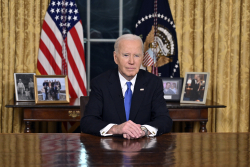The proliferation of drone warfare has had an immense psychological and strategic impact on both Russian and Ukrainian troops.
The ongoing war in Ukraine has highlighted the evolving application of weaponized drones in warfare. Both sides have become increasingly dependent upon drones, the tactics of which have evolved over the course of the four-year conflict.
Drones have been involved in the war almost since the outset. But what began primarily as an improvised reconnaissance function has evolved into a high-intensity drone arms race, with both sides integrating drones into nearly every facet of the conflict, ranging from intelligence and surveillance to precision strikes, electronic jamming, and psychological pressure.
Drones Can Do More on the Battlefield than Ever Before
The earliest and most obvious application of drone warfare was the tactical application of commercial drones—which swiftly became everyday tools for infantry units early in the conflict. Commercial drones were used to locate enemy positions, adjust artillery fire, spot armored movement, and scan trench lines. These relatively cheap, off-the-shelf drones were easy to deploy and drastically improved situational awareness while reducing risks to personnel.
As drone use became more widespread, both sides began to experiment with their drones’ capabilities—quickly leading them to take on roles far more sophisticated than simple reconnaissance. By 2023, both sides had begun using first-person view (FPV) kamikaze drones to target enemy soldiers and vehicles. As the name suggests, kamikaze drones—also known as “loitering munitions”—are modified commercial drones that are loaded with explosives and flown into tanks, bunkers, or moving vehicles. Because the drone is cheap and expendable, it can be flown directly into its target and detonated, providing remarkable accuracy that conventional weaponized drones—which had previously hovered above a target and dropped their payloads—lacked. Small and highly maneuverable quadcopters operated by pilots wearing VR goggles, the kamikaze drones proved cheap and highly effective for offering stealthy, precise, and psychologically damaging impacts—forcing troops to constantly scan the skies for these tiny invaders.
Notably, unlike cruise missiles or artillery shells, kamikaze drones were adept at navigating with articulation—around trees and bunkers and obstacles, making them lethal in both urban and forested combat zones.
Russia Uses Drones to Target Ukraine’s Civilian Infrastructure
Both sides have adopted long-range drones to strike critical infrastructure. For example, Ukraine has launched DIY long-range drones with 1000-kilometer-plus range, used to target oil refiners, radar stations, and airfields deep within Russian territory. Russia for their part has reciprocated, deployed the “Geran-2” drone, a variant of the notorious Iranian Shahed-136. Russia has used Shahed and Geran drones to attack Ukrainian power plants and air defense systems, using swarm attacks overnight to saturate defensive measures and inflicting psychological and economic pressure on the Ukrainians. While the Shahed drones are slow and easy to detect, they are also cheaply mass-produced, meaning the Russians can keep sending them in waves—which is effective through attrition, especially when combined with missile barrages.
The proliferation of drone warfare has had an immense psychological and strategic impact on both Russian and Ukrainian troops. The omnipresent nature of drones has reshaped how soldiers fight. Now, both sides’ units hide under camouflage nets at all times, troop movement is conducted at night or in fog, and morale is far lower.
In sum, drone tactics and strategy have continued to evolve throughout the Ukraine War, in ways that will likely be studied and put to use in other conflicts. Throughout the conflict, drones have become indispensable tools for war fighting. In retrospect, the ongoing conflict in Ukraine will be the war that normalized drone warfare—an inevitability that analysts have been expecting for some time and which now seems to have fully occurred.
About the Author: Harrison Kass
Harrison Kass is a Senior Defense and National Security Writer at The National Interest. Kass is an attorney and former political candidate who joined the US Air Force as a pilot trainee before being medically discharged. He focuses on military strategy, aerospace, and global security affairs. He holds a JD from the University of Oregon and a master’s in Global Journalism and International Relations from NYU.
Image: Shutterstock / Melnikov Dmitriy.

















